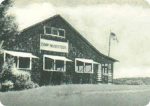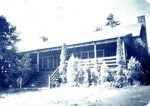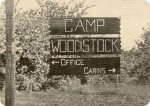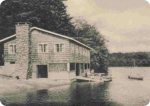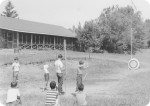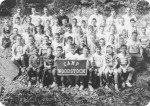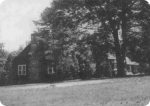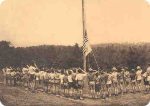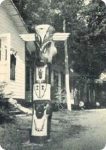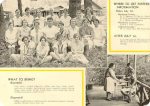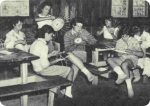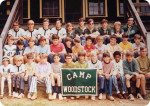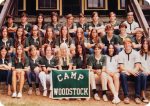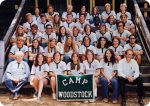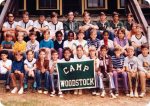Beginnings
Camp Woodstock began with a vision and a car ride in 1922. The vision and the car belonged to Elmer Thienes, a Congregational minister from Marlborough, Connecticut, who also served as the director of the Hartford County YMCA. After seeing an ad in the paper for eleven acres of woods and farmland, he drove to the wilds of Woodstock, parked in front of a huge pine tree – just a stump today next to an entrance to the Boathouse – and looked around. In front of him was a beautiful glacial kettle lake, unspoiled by development; to his right was one of the three remaining old growth white pine forests in the state; behind him was a cleared field, perfect for the surplus World War I army tents he envisioned for his camp. “I’ll take it,” he said to the farmer sitting next to him. For $4,000, lakeshore waterfront, pine forest, field and farmhouse were purchased. Sixteen years later a hurricane would destroy most of the pine forest along with the majority of the small cabins that had replaced the tents. His vision, however, was not made of wood and canvas. The camp would endure.
The Early Years
The first campers arrived in the summer of 1922. Among them was the eleven-year Emerson Reed, who 75 years later would recall the experience at Camp Woodstock’s 75th Reunion in 1997. Self-sufficiency was an honored quality at camp, and Emerson remembered that building his own bed from boards and canvas was required of everyone who did not want to sleep on the ground. Showers were still in the distant future. Early morning dips in the cold waters of Black Pond sufficed. By 1931 small wooden cabins had replaced the army tents, and the cost of camp had climbed from $7 to $9 per week. In 1936 a popular and mischievous boy from Wethersfield named Tommy Tryon attended his first season at camp. He would later become a celebrated movie star and bestselling author. His last book, a New York Times best seller, The Night of the Moonbow, written in 1989, told the fictionalized tale of his camping experience at Woodstock and would give birth to the legend of Woodstock Charlie, the camp’s favorite ghost story.
Catastrophe and Resurgence
In 1938, Camp Woodstock, along with much of coastal New England, was obliterated by a devastating hurricane. The minutes of the camp board of managers record every member stating that the camp could not go on. There was simply no camp and no money left. Director “Pop” Thienes was the last to speak. His words are recorded as follows, “We are asking the wrong question. It is not whether to go on or not, but only how.” He would soon raise the funds not only to replace the cabins, but also to build what we now call Pop’s Lodge from the downed pines that littered the ground where the majestic forest had stood.
Watch Part 1 and Part 2 of some great archival footage.
Into the Modern Era
In 1950, Lewis Knox took over the directorship of the camp from Elmer “Pop” Thienes. Even though World War II had brought the seeds of change to the nation, Mr. Knox carried on the same spirit and character-driven values that Pop had. By the time Louis Knox retired from the camp in 1968, he had been elected into the YMCA Hall of Fame. The seeds of change would begin to sprout during the tenure of Woodstock’s next director, Fred Wirth. In 1969, girls’ camp and boys’ would merge into one. The emphasis on rugged individualism and athleticism was softened. In 1969 Fred negotiated to dissolve the Woodstock Camp Corporation of the Tolland, Windham, and Hartford County YMCA’s into one single branch of the Hartford County YMCA. Within a few years he had made major facility improvements and almost doubled Woodstock’s acreage through the camp’s first capital campaign since 1939. It is a testament to Camp Woodstock’s intrinsic character that in the 98 years of its existence only seven directors have led it. Since Fred Wirth’s directorship, Steve Taylor, John Bennett, Mike Sherman and Tony Gronski have each contributed to the essential continuance of the Woodstock Spirit, that intangible but very present quality that has endured through natural disasters, world-wide wars, economic downturns, and cultural revolutions.

